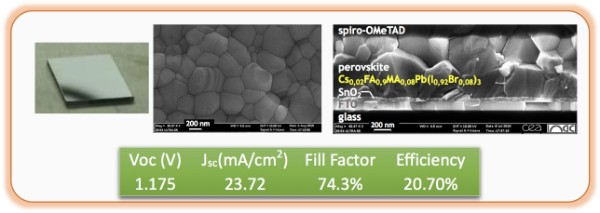 Extremely thin absorber (ETA) solar cells
Extremely thin absorber (ETA) solar cells
In ETA solar cells we are using colloidal semiconductor quantum dots (QDs), forming a thin layer on a nanostructured semiconductor, as light absorbers. We are developping in particular the synthesis and application of toxic heavy metal free QDs, like chalkopyrite (CuInS
2, CuInSe
2) and kesterite (CZTS) nanocrystals,
cf.
J. Mater. Chem. A 4 (2016), 827-837
 Perovskite solar cells
Perovskite solar cells
Perovskite solar cells have a very high potential to outperform established solar cell technologies, as they combine low-cost fabrication and high performances. Photovoltaic cells using lead-halide based organic/inorganic hybrid perovskite absorbers show high open-circuit voltages (>1V) and power conversion efficiencies (>20%). On the other hand, several challenges persist, in particular the enhancement of long-term stability and the development of lead-free materials showing similar perfomance. Our research in this field focusses on the development of nanostructured n- and p-type electrodes, hole transporting materials and alternative lead-free perovskites. We also perform in-depth structural studies (neutron scattering, synchrotron and conventional X-ray diffraction) in order to achieve better understanding of structure/properties correlations and of crystallization mechanisms in hybrid perovskites,
cf.
J. Phys. Chem. C 2017, 121, 7596-7602
